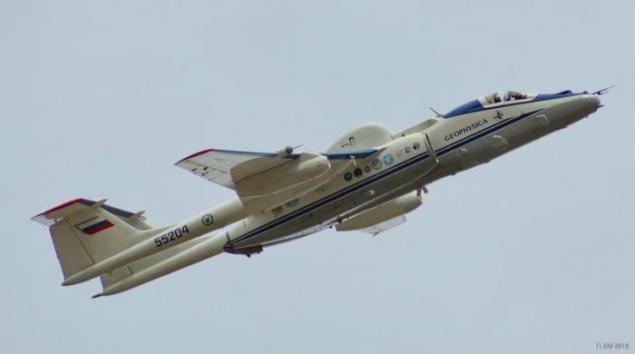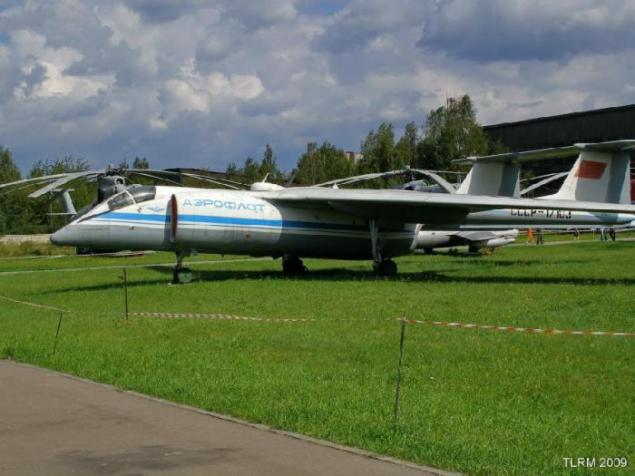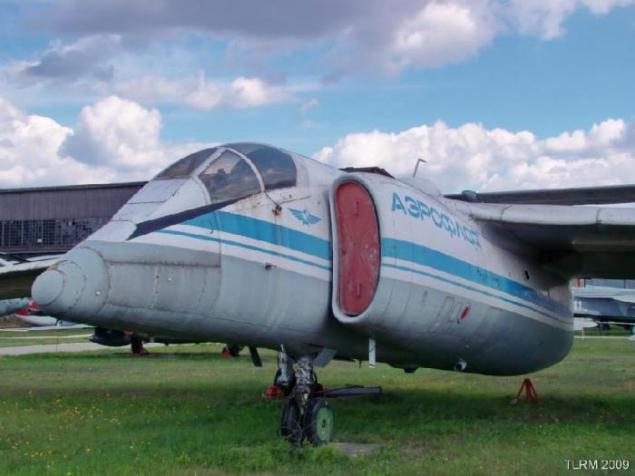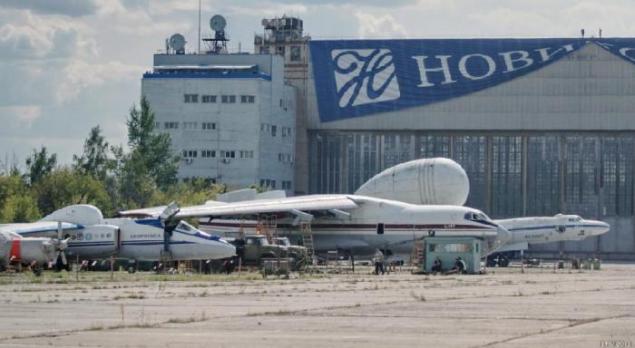Relay M17 Stratosphere - M 55 Geophysics
 Bashny.Net
Bashny.Net
M 55 Geophysics
A little history of these machines. M 17, named later "Stratosphere" started to be developed in the 70s, the era of high-altitude subsonic scouts direct high aspect ratio wing, U-2 was coming to a close. USSR firmly closed its borders various air defense systems and the Americans did not dare to openly invade the airspace of well learned the lessons of the 1960s. Replacing manned aircraft to fly radio-controlled probe, the US continues to collect Intelligence information over the Soviet Union, using the winds blowing from west to east at high altitude. The probes were able to change the altitude and controlled by radio. It is understood that the launch of the probe with the hardware cost much less trigger anti-aircraft missiles.

to deal with such probes, and was designed in KB Myasishcheva M 17. Saprosy military air defense and, in particular, asked very high requirements for the aircraft. He had to carry a steady horizontal flight at an altitude of 21,000 meters and be able to shoot out of a cannon probes installed on board. Due to the low rate flight rapprochement with the probe occurred at the speed at which the pilot, after some training, more time to adequately respond to the situation. Drills shooting took place at a converted TU-16.
Creating aircraft M 17 was very difficult. The main problem was that at high altitude usual airfoils become very inefficient. The prototype of the layout scheme has served two beam Su-12. Just in KB Myasishcheva been exhaustively studied the remains of the period 1960-1965gg downed U-2 Lockheed. Of whom there are 6 pieces. One (the most famous episode) was shot down over Sverdlovsk, one Soviet calculation over Cuba and 4 abyli aircraft shot down by the same S-75 over China. U-2's was unique in its own way by plane, but had a much longer wing could take off and zaditsya only in calm weather and had a very low capacity. No. 17 had to be virtually all-weather ups and implement the alarm at any time of the day or night. Designers KB Myasishcheva managed to create a unique wing that due to mechanization changed the flow profile and had a high efficiency and at high and medium and low altitude. The first flight of M 17 were not planned and led to the absurd tragedy. In December 1978 the first instance crashed.
The second aircraft was built only in 1982. As it happens, the M 17 is the latest brainchild of VM Myasishcheva who died in the same in 1978 shortly before the disaster of the first sample.
The surprising fact, but in M 17 was not in the servo control system. That is, he was almost "direct transfer" with the control surfaces on the handle. We use only the mechanical system boosters and baffles. This was done to facilitate the construction. And the designers were able to still achieve acceptable effort for pilots.
In the 90 years the M 17 was a deeply modernized and received the name of M 55. According to the designers, perhaps the only unit not undergone changes in the remaining chassis. Wings have become a little shorter and longer fuselage, established on M 55 2 engine range has increased almost 4 times and the time spent in the air has increased to 6 hours. This aircraft is one of the few in the world who can make cruising at an altitude of 21 km. Within the framework of the international experiment (Airborn Polar Experiment) 55 M was traveling izItalii, where he worked for another international program in Finland. The way he ran, including over Germany and Sweden. Over Germany it tried to accompany a pair of Mig-29 Luftwaffe over Sweden and a few J-37 Viggen, but to get to the M 55, they could not.
Now the aircraft has a very high flight characteristics for its class and can be used in a very wide range of both military science and national economic trends. Perhaps that will be created double version of this aircraft.

M 17 TSMA in Monino

M 17 TSMA in Monino

M 17 TSMA in Monino

M 55 LII parked KB Myasishcheva preparing for a demonstration flight

M 55

M 55

M 55

M 55
A little history of these machines. M 17, named later "Stratosphere" started to be developed in the 70s, the era of high-altitude subsonic scouts direct high aspect ratio wing, U-2 was coming to a close. USSR firmly closed its borders various air defense systems and the Americans did not dare to openly invade the airspace of well learned the lessons of the 1960s. Replacing manned aircraft to fly radio-controlled probe, the US continues to collect Intelligence information over the Soviet Union, using the winds blowing from west to east at high altitude. The probes were able to change the altitude and controlled by radio. It is understood that the launch of the probe with the hardware cost much less trigger anti-aircraft missiles.

to deal with such probes, and was designed in KB Myasishcheva M 17. Saprosy military air defense and, in particular, asked very high requirements for the aircraft. He had to carry a steady horizontal flight at an altitude of 21,000 meters and be able to shoot out of a cannon probes installed on board. Due to the low rate flight rapprochement with the probe occurred at the speed at which the pilot, after some training, more time to adequately respond to the situation. Drills shooting took place at a converted TU-16.
Creating aircraft M 17 was very difficult. The main problem was that at high altitude usual airfoils become very inefficient. The prototype of the layout scheme has served two beam Su-12. Just in KB Myasishcheva been exhaustively studied the remains of the period 1960-1965gg downed U-2 Lockheed. Of whom there are 6 pieces. One (the most famous episode) was shot down over Sverdlovsk, one Soviet calculation over Cuba and 4 abyli aircraft shot down by the same S-75 over China. U-2's was unique in its own way by plane, but had a much longer wing could take off and zaditsya only in calm weather and had a very low capacity. No. 17 had to be virtually all-weather ups and implement the alarm at any time of the day or night. Designers KB Myasishcheva managed to create a unique wing that due to mechanization changed the flow profile and had a high efficiency and at high and medium and low altitude. The first flight of M 17 were not planned and led to the absurd tragedy. In December 1978 the first instance crashed.
The second aircraft was built only in 1982. As it happens, the M 17 is the latest brainchild of VM Myasishcheva who died in the same in 1978 shortly before the disaster of the first sample.
The surprising fact, but in M 17 was not in the servo control system. That is, he was almost "direct transfer" with the control surfaces on the handle. We use only the mechanical system boosters and baffles. This was done to facilitate the construction. And the designers were able to still achieve acceptable effort for pilots.
In the 90 years the M 17 was a deeply modernized and received the name of M 55. According to the designers, perhaps the only unit not undergone changes in the remaining chassis. Wings have become a little shorter and longer fuselage, established on M 55 2 engine range has increased almost 4 times and the time spent in the air has increased to 6 hours. This aircraft is one of the few in the world who can make cruising at an altitude of 21 km. Within the framework of the international experiment (Airborn Polar Experiment) 55 M was traveling izItalii, where he worked for another international program in Finland. The way he ran, including over Germany and Sweden. Over Germany it tried to accompany a pair of Mig-29 Luftwaffe over Sweden and a few J-37 Viggen, but to get to the M 55, they could not.
Now the aircraft has a very high flight characteristics for its class and can be used in a very wide range of both military science and national economic trends. Perhaps that will be created double version of this aircraft.

M 17 TSMA in Monino

M 17 TSMA in Monino

M 17 TSMA in Monino

M 55 LII parked KB Myasishcheva preparing for a demonstration flight

M 55

M 55

M 55

M 55
Tags
See also
Theories possible end of our universe (11 photos)
The drone Zephyr managed to climb to record high
Scientific achievements in 2013 (7 photos)
Future
Nuclear explosions
There is a science - astrology.
The biggest successes of science in recent years (7 photos + video)
At the dawn of nuclear technology
7 crazy facts that science has learned about the human body in recent years
The world in 2030: what will change in science, technology and the labour market

















